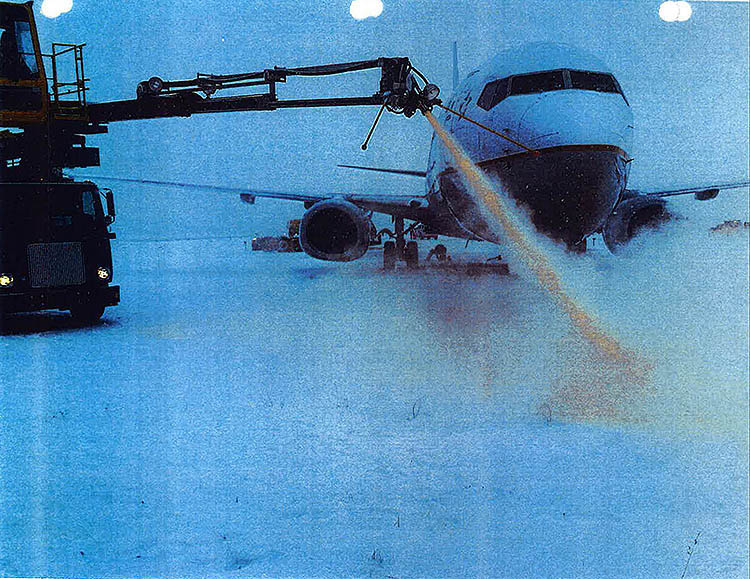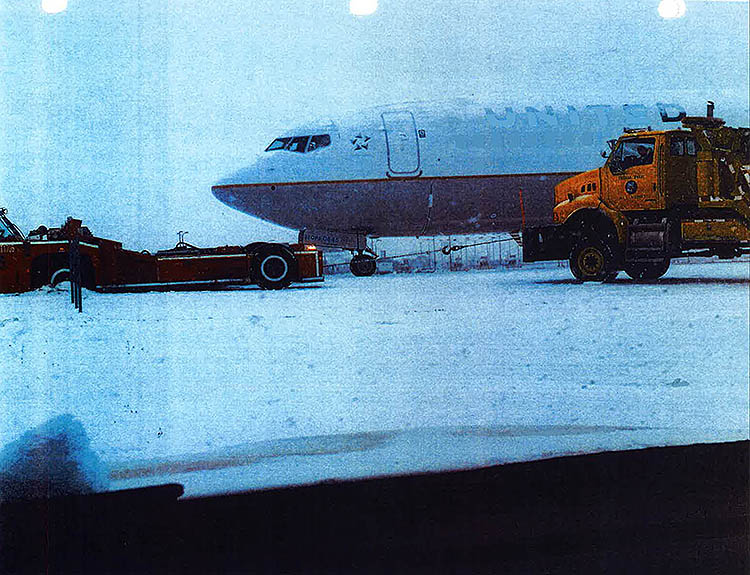Pilot Fatigue, Error Raised In Probe Of O’Hare Runway Mishap

The pilots of a United Airlines plane that slid off an O’Hare Airport runway last December had been awake for 23 hours or more at the time of the incident and discussed feeling “fatigued” even before departing Seattle for Chicago with more than 160 passengers on board, according to a recently obtained Federal Aviation Administration document.
What’s more, the pilots apparently believed they were landing on a different, longer runway at O’Hare, and may have made a series of braking errors while trying to bring the jetliner to a stop, according to the document, which also notes the landing strip was “obscured by snow.”
The paperwork – turned over by the FAA in response to an open records request from the Better Government Association – does not give an exact cause for the Dec. 30 runway “overrun,” and officials at the FAA and United Airlines said that their investigations are ongoing, so it’s too early to point fingers or give too much weight to the information.
“It is a very small piece of a larger investigation,” said FAA spokeswoman Elizabeth Isham Cory, describing the two-page document as “non decisional.”

Photos of Flight 1977 overrun obtained from Chicago Department of Aviation.
Still, the document provides a more-detailed glimpse as to what may have been going on in the cockpit and on the ground, and raises serious questions about pilot judgment, FAA oversight and the Chicago Department of Aviation’s ability to clear the airfield during wintry conditions.
It was a snowy morning with temperatures in the 20s when the Boeing 737, operating as Flight 1977, touched down on Runway 9 Left/27 Right, which stretches 7,500 feet and opened in 2008 as part of O’Hare’s ongoing expansion and reconfiguration project.
An FAA air traffic controller cleared the plane for landing and said “braking action” was reported as “good” – meaning not too slippery, according to a copy of radio transmissions.
But soon one of the pilots reported, “Be advised, braking action was nil,” meaning the tires weren’t catching on the pavement very well. The aircraft ended up off the runway, and records from the aviation department, which falls under the domain of Mayor Rahm Emanuel and operates O’Hare and Midway airports, indicate the plane slid. In fact, city crews were standing by to conduct a “friction” test and, if necessary, clear away snow and ice.
Nobody was injured.
The recently obtained FAA record said the captain of Flight 1977 was awake for 25 hours “at the time of the incident,” while the first officer – the second pilot – was awake for 23 hours.
“Crew discussed being fatigued at length prior to departure from [Seattle], but felt compelled to complete the mission,” the document stated. “Crew discussed napping as a fatigue mitigation strategy enroute.”
The FAA document also indicated:
- The pilots “thought they were landing on the longer of the parallels [runways], but in fact were landing on the shorter.”
- The pilots may have “inadvertently selected” a less-powerful brake setting and did not accommodate for the runway being “obscured by snow.”
- The captain, even though he was fatigued, “decided to hand fly” the plane from 10,000 feet to arrival rather than let autopilot handle things.

Photos of Flight 1977 overrun obtained from Chicago Department of Aviation.
The FAA, which regulates airspace, airports and airlines, requires that pilots have a “10-hour minimum rest period prior to the flight duty period” with “an opportunity for eight hours of uninterrupted sleep within the 10-hour rest period.”
But “rest” doesn’t necessarily mean “sleep,” and an “opportunity” for sleep also doesn’t necessarily mean actual snoozing, aviation experts said. Either way, the FAA record doesn’t delve deeply into this topic with the Flight 1977 crew.
Bill Waldock of Embry-Riddle Aeronautical University noted that FAA rules also put great responsibility on pilots to not fly when they are overly tired. “They have to positively affirm that they are fit for duty” before taking off, Waldock said.
Brian Hennessy, a pilot and principal of the consulting firm Blue Hawk Aviation, said the major carriers take fatigue much more seriously now than in the “old days” and don’t hesitate to yank pilots from duty if they report being too tired.
Referring to the number of hours the Flight 1977 pilots were reportedly awake, Hennessy added, “If that’s true, I can easily see” how mistakes could have been made.
According to the FAA, “Fatigue is characterized by a general lack of alertness and degradation in mental and physical performance. Fatigue manifests in the aviation context not only when pilots fall asleep in the cockpit in flight, but perhaps more importantly, when they are insufficiently alert during take-off and landing. Reported fatigue-related events have included procedural errors, unstable approaches, lining up with the wrong runway, and landing without clearances.”
The FAA record obtained by the BGA indicated one or both Flight 1977 pilots “will receive” training in, among other things, “cold weather ops” and “fatigue risk management.”
United spokesman Charles Hobart would not confirm the training or divulge other details, only saying the airline is still conducting an “internal review” but believes “there may be other contributing factors involved” beyond possible fatigue and pilot error, including “possible runway conditions,” weather and “ATC,” or air traffic control.
Chicago Aviation Commissioner Ginger Evans wouldn’t comment.
The Dec. 30 incident was one of three similar overruns at O’Hare on the same runway during the winter. There have been at least nine “excursions” from O’Hare runways and taxiways since 2010, city records show.

Selections from FAA documents regarding Flight 1977.













 Soon, he’s going to be an inmate, after pleading guilty last month to transportation of child pornography and, in the process, admitting to some pretty sordid stuff.
Soon, he’s going to be an inmate, after pleading guilty last month to transportation of child pornography and, in the process, admitting to some pretty sordid stuff. 



 Simon, a former Chicago cop, said via email, “as a former member of law enforcement in the community I believe my donation speaks for itself.”
Simon, a former Chicago cop, said via email, “as a former member of law enforcement in the community I believe my donation speaks for itself.”
